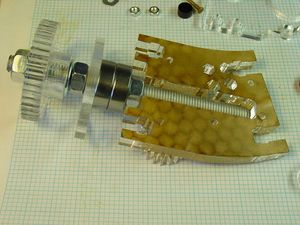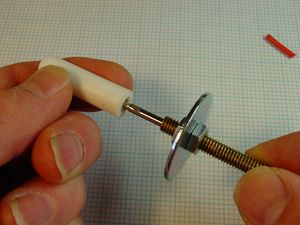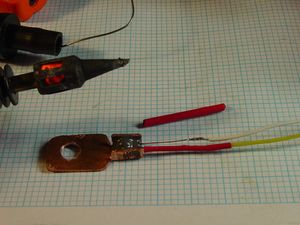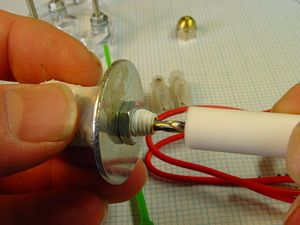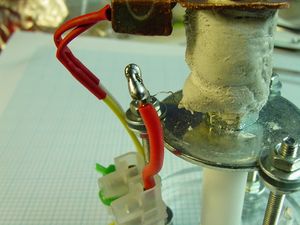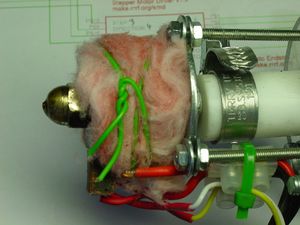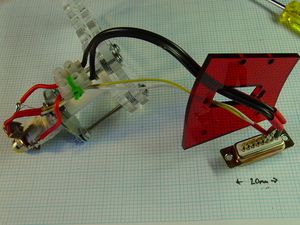PonokoExtruderAssembly
Assembling the Ponoko RepRap Extruder
| [PonokoRepRap Main Ponoko Page] | ||
| Beginning | Next Step | |
| BOM for this page |
Construction and assembly of the Extruder is quite demanding. There is a 3mm hole to be bored straight down a 40mm long rod, a 0.5mm hole to be drilled and some rudimentary lathing to be done. If you have a smattering of DIY skills, you should be able to accomplish this with a power drill and a few nifty tricks. If not feeling quite up to the challenge and unable to find a helpful person with a lathe nearby, buy the bits from the RRRF, Diamond Age, or BitsFromBytes. The source files for cutting the extruder only are available at http://reprap.svn.sourceforge.net/viewvc/reprap/trunk/users/vik/plywood-robot/acrylic/extruder/ - reprappers cutting discount can be applied.
Modifications
A number of modifications have been made since the first kits were shipped. Illustrations may differ while we get our act together. The extruder is probably the most awkward part of the RepRap to get going, and as small variations can have a huge effect the design is not yet foolproof. The major modifications are:
Use of Fibreglass Insulation
Unless the heater is insulated with some fibreglass, the temperature reached by the barrel in order to cause a reasonably warm nozzle may cause the PTFE to soften and even heat the acrylic parts above.
16mm PTFE Rod
The original use of 10mm PTFE rod had proved to be inadequate in many situations, probably dependent on the density of the PTFE used and the accuracy with which the heater barrel is crafted. It has been replaced with 16mm PTFE rod. The hole receiving the 10mm rod can simply be reamed or drilled out to accommodate the wider rod.
Hose Clamp on PTFE/Barrel Junction
A sturdy galvanized hose clamp is used to compress the junction between the PTFE rod and the heater barrel to eliminate leaks and prevent the PTFE from bulging under load.
Bearing Surface for Drive Screw
The filament is pushed by a captive bearing against a threaded rod used as the main drive screw. This is then pushed into the side of the acrylic extruder body. In order to lessen the friction and prevent the screw thread bedding in, a piece of hardened box-cutter blade is sandwiched in at a strategic point.
Clutch Disabled on GM3
The operating torque of the GM3 motor is such that the clutch built into it often skips. The clutch must be disabled.
Canting of GM3
Under the torque used to push the threaded drive rod, the acrylic gears can be forced apart. The motor and small gear are canted towards the large gear to compensate.
Mounting Hole Improvements
Mounting holes have been modified to suit a wider range of motors and to make some GM3's easier to fit.
Gear Centres
The centres of the small acrylic gears have been provided with a system of inserts to allow various types of motor shafts to be used with them.
Assembly
Start by finding the components and fastenings as shown. We'll build the Extruder Heater Assembly later.
Take a piece of <part>M8 studding 110mm</part> long and wind a <part p="M8">nut</part> down it about 60mm. Add <part>two 608Z skate bearing</part>s and a 12mm o/d M8 spacer cut from 4.5 or 5mm acrylic. Add the Extruder Bearing Stop, making sure the notch in it faces anti-clockwise when viewed from the top of the M8 studding as shown
Screw on another <part p="M8">nut</part>, add a <part p="M8">washer</part> and the 20mm o/d M8 spacer cut from 8mm acrylic. Screw on another <part p="M8">nut</part>, slip on the large gear wheel and secure with a <part p="M8">washer</part> and <part p="M8">nut</part>. Shuffle the nuts so that when the lower nut is held against the neck of the 8mm Extruder Body Segment, the bottom of the studding misses the end of its slot by about 1mm as shown on the right. Once you have it fitting, tighten all the M8 nuts very firmly. The extruder generates surprising torque and will unravel the nuts given half a chance. It has been reported that adding an extra M8 nut in the centre there where there's just one shown keeps the extruder bolt from creeping, and may line the top M8 gear up with the gearmotor better.
Put <part p="two M5">washer</part>s on the <part>two M5 30mm screw</part>s and put them into the Bearing Stop - it'll be very hard to do this soon without removing the large gear. From the other (let's call it bottom) end of the M8 studding, slide on the Extruder Motor Bracket, taking care to align the small notch with the one on the Bearing Stop. Then slide on two 3mm Extruder Bearing Brackets and one 5mm Extruder Bearing Bracket so that the two 608Z bearings are completely enclosed. Put <part p="two M5">nut</part>s on the <part>two M5 30mm screw</part>s loosely, just to hold things together while we fit the Extruder Motor.
Several kinds of <part>gear motor</part>s are supported, and they have different shaft shapes and sizes. Pick the smaller 8mm acrylic gear with the appropriate centre hole and insert (if necessary) for your motor's shaft. If none fit your motor, make with a Dremel tool or epoxy as appropriate. For the GM3 and similar motors, put <part>two M8 washer</part>s on first, then fit the gear.
Find a <part>small woodscrew</part> or truncate a slightly oversized one. The thread only goes half way up a woodscrew so you'll need an M3 spacer or stack of washers to take up the slack. DO NOT just drive the screw into the motor's gearbox!
The M8 washers should hold the gear above the annoying little projections on the gearbox case.
Slip washers onto <part>two M3 30mm screw</part>s and use them to hold the motor onto the Motor Bracket. If you need to modify the bracket to take your motor, ensure that the gears mesh closely. The motor bracket will flex in use.
By adding washers underneath the motor on one side or the other, it is possible to make the motor lean towards or away from the large gear and thus bodge around any minor imperfections in bracket modification. It is recommended that the motor cants slightly towards the larger gear.
Secure with washers and nuts.
The Extruder Motor Assembly is now complete and can be put safely to one side.
Now to assemble the Extruder Body. This holds the screw thread and incoming filament together, driving it towards the heater barrel. Here is what a set of parts looks like, short eight absconding M3 spring washers:
Start by putting <part p="four">large M3 washer</part>s on the <part p="four">M3 40mm screw</part>s, and put them into the front of the Extruder Body segments. That's the one with the square group of 4 holes in it, not a square group of hexagonal holes. Your parts may have less cat hair than mine, but that's okay:
Fit the two parts of the divided segment on next. There should be a 3mm channel dividing the two parts. That's where the filament goes.
Add the 8mm segment. Now is a good time to pop <part>4 M3 nut</part>s one in each of the hexagonal holes. It can be done later, but now is easier if the holes are tight.
Put a piece of hardened steel box-cutter blade over the end of the trough where the threaded drive rod will go, sharp edge towards the bottom of the extruder. You can add a little tape or glue to hold it in place during assembly. This will form the bearing surface for the drive rod to be pushed against, so the tip of the drive rod should rest squarely within the area covered by the blade.
Note: This photo is a mock-up for showing the blade location only.
Slide on the final segment, add washers and nuts - do not fully tighten, this is just to hold things in place while we do the wiring.
Secure with <part>M3 20mm screw</part> through the central hole with a <part p="M3">nut</part> and <part p="two M3">washer</part>s. This can be tightened.
Make the Extruder Idler by slipping a <part>625ZZNSK bearing</part> onto an <part>M5 30mm screw</part> with a relatively small head. That was hard, eh?
If you have <part>four small, stout springs</part>, put them on <part>four M3 20mm screw</part>s. Otherwise, put a spring (or split) washer on each screw, then a small M3 washer, then another spring washer, then another plain one as shown.
Use the four spring washer assembles one by one to attach the small rectangular Extruder Idler Clamp, clamping the Idler in place over the window in the front of the Extruder Body.
Just catch the four M3 20mm screws in the semi-captive nuts in the Extruder Body, trapping the Extruder Idler in place, do not tighten fully or you'll not get the filament in.
It may be helpful to push on the semi-captive nuts when inserting the screws. A chopstick seems to do the job.
Get a piece of 3mm filament about 250mm long and poke it into the slot that goes down the middle of the laminated Extruder Body.
Remove the M5 nuts from the Extruder Motor Assembly and put the filament through the feed hole. If the feed hole is rough or too tight, ream it with a 3mm or 1/8" drill.
Put the two M5 nuts into the slots in the Extruder Body and fasten the Motor Assembly and Body together, ensuring that the filament can still move smoothly. I actually found it easier to reach the M5 screws by temporarily removing the large gear. Some M5 nuts can be too thick to fit into the slots. Check that the M5 nuts will fit, preferably before you purchase them.
Now you can tighten the screws with the spring washers a bit to grip the filament. When you can't easily move it, it's gripped. Do not over-tighten or you'll break the clamp.
Wire up a few volts across the motor and check everything moves - including the filament. Slacken and tighten nuts, wriggling segments if necessary.
Preen.
Tighten the M8 nuts.
Build a PTFE Extruder Heater Spacer. Basically this is <part>a 35mm piece of 16mm diameter PTFE rod with a 3mm hole drilled down the centre</part>. One end of the hole is chamfered, the other end tapped for 6mm with an M6 hole. Use a 4.5mm starter hole for the tap as PTFE is very soft.
No lathe? Me neither. I use an electric drill as a lathe. Basically you rotate the workpiece and file it to shape things like the nozzle or chamfering. If you've not been taught to use one, go look up the safety precautions and please at least wear safety goggles. Be warned that lathes are very efficient at sucking loose things in, like hair and clothing, or alternatively throwing things out very fast, like chuck keys.
To drill centred holes, construct some kind of movable vice-like holder for the drill bit (nice and sharp please). An old chuck? Some metal plate and a lot of clamps? Old drill press? I use a Z-Vise2, a pipe clamp and some G-clamps.
When you advance the bit into the workpiece, as long as you're basically on centre physics keeps you there. Do pause occasionally to let the swarf (curly waste bits) out. Take your time and do not even come close to stalling the drill. This is more difficult with harder materials.
Build a heater barrel. This is <part>a 40mm long piece of M6 brass bolt with a 3mm hole drilled right down the middle</part>. Make it say 45mm long and file off the worst end. Chamfer the hole on the end that will screw into the PTFE and make the other end as flat as you can to give a good seal on the nozzle. Clean the threads.
Now find the components as shown. Fire cement, heater barrel, <part>two M6 half- or press-nut</part>s, <part>one M6 washer</part>, the PTFE Heater Spacer and an <part>M6 32mm o/d washer</part>. You will also need an <part>M6 dome nut</part> to help with sizing, and <part>200-300mm of nichrome wire with a resistance of about 8 ohms</part>:
Put a couple of M6 half nuts on the heater barrel about 10mm from the end, trapping the large M6 washer between them. Put a 3mm drill bit or other handy 3mm rod partly into the heater barrel and use this as a guide to screw the barrel into the soft threads on the PTFE Spacer. If you don't do this every time, you will find yourself crossing the PTFE threads. Not good.
Tighten the nuts up so that they are flush with the PTFE Spacer. Then unscrew the Spacer and remove the 3mm drill bit.
Put an <part>M6 dome nut</part> and <part p="M6">washer</part> on the end of the barrel to keep cement out and guide you as to where the cement should finish. You'll prise off the washer when the final layer of cement is dry. Do not use a thick first layer - just enough to stop the wire coming into contact with the Heater Barrel. Allow for shrinkage, cracks and other events.
Lay down one layer, dry and shape. Use smooth fireproof cement according to the maker's instructions. Avoid overly coarse furnace cement as it drops bits. A flexible craft knife makes a good initial applicator, and a drill or lathe chuck holds things in a rotateable way. Do not turn the drill or lathe on or you will wear the cement! Tapping the cement with a finger is a good way to smooth it down once it is laid on and partly dry.
Time to wrap with wire. Use 8 ohms of nichrome wire - a 200-300mm length depending on the wire. The insulated "Pelican Wire" sold by the RRRF is ideal. Put the windings slightly closer together - but not even close to touching - at the nozzle end. Leave enough exposed to hitch things up to and make sure it doesn't short on any metal part.
Cover with more cement. Dry as per manufacturer's instructions. Add a third thin layer, mostly cosmetic but you're not under pressure to keep the filament wired up now as it is held firmly in place. Dry and then fire in an oven to curing temperature - or put it in with the roast and trust to luck like I did.
The finished heater element.
Some cements - a small-scale test is a good idea - fuse when heated to red heat in a blowtorch and go very solid. If it does, you can make your extruder more physically durable that way.
Do not heat the filament ends more than cherry-red though. You can burn through the filament if you try hard like I did. It sucks, as the youths will have it.
If you're using a thermistor or thermocouple heat sensor that does not come with a tag, make one out of a piece of copper sheet. I use flattened out copper water pipe. This lets you change the thermistor or thermocouple without having to rebuild the entire barrel.
Cut and score the copper to make a small handle at one end of the tag. Drill a 6mm hole in it to accept the Heater Barrel and tidy up the edges.
Do make sure that the tag will fit on the Heater Barrel without its handle colliding with the element. Measure yours - it may be wider than mine and you'll need to move the 6mm hole.
Epoxy the sensor to it with high-temperature metal-loaded epoxy such as JB Weld or the better class of stuff for fixing heatsinks. Prop the thermistor up if necessary to ensure that its leads do not short against the copper.
Solder flexible stranded wire to the thermistor leads, cut to 25mm, and protect with heat-shrink to avoid shorts.
Make yourself a nozzle or two as per these pictures:
Lock the dome nut on to a bit of sacrificial M6 threaded rod - a chopped-off M6 screw is handy. You will damage the thread if you do the chuck up tight enough. Hand lathing causes a lot of vibration so do everything up super-tight.
Note that the drill is switched into reverse when lathing from underneath to avoid crud being flung at the eye-protection-wearing user. It's better than lathing from on top because you can see what is happening to the metal.
Push the file to the right (if you're set up like this photo) to bite in, then round things off a bit and finally shape the nozzle itself. Start with a coarse file, finish off with a fine one.
Yours should look a lot like this. A gently tapering tip about 1.5mm wide at the end.
Gripping the edges of the dome nut, pull it down onto a 0.5mm (a 1.0mm one is recommended for your first nozzle) drill with your fingers. Try not to perforate them if the drill breaks. It is quite painful, but the blood washes of the dome nut just fine.
Chances are that the nut will have a little dip in its head at the centre. If it does, use that to centre your drill bit on.
Keep pulling the nut gently but firmly by the sides, doing your best to keep it central.
Do not rest the nut or put it in a vice and drill down into it.
By the magic of physics, things again contrive to centre the drill bit and you should achieve breakthrough in the middle of the nozzle with minimal effort. Do not push so hard you start to stall the drill.
Now use a tapered burr (see picture) to put a sloping edge on the inside of the hole. This dramatically reduces the nozzle's operating pressure, but if overdone can sever the base of your finely machined nozzle.
It's not a fluke. It can be done repetitively.
DO NOT file across the nozzle. If there is cruft in the central hole, push at it from both sides with a needle until it falls out. If you must, use fine grit carbide paper on a flat surface. But you really shouldn't have to.
These are the parts we'll need next for the Extruder Clamp and Heater Assembly:
Take the lollipop-shaped two sections of Extruder Clamp and <part>three M3 50mm screw</part>s. Put washers on the screws and put them through the Clamp with the 3mm hole in the centre of the round portion. Put approximately 3mm-worth of <part p="15">M3 washer</part>s on each screw, then add the other Clamp piece.
Pinch the assembly together and try it for fit in the X Carriage Extruder Socket. Add or remove washers until it slots firmly in yet can be comfortably removed without breaking the X Carriage.
Add a <part p="three M3">washer</part> and <part p="three M3">nut</part> to each of the three M3 50mm screws. Tighten the nuts. Put nuts and washers approximately 10mm down the screws.
Wrap the short end of the Heater Barrel thread with <part>PTFE tape</part> to ensure a good seal and screw the barrel into the PTFE Spacer using the 3mm drill bit trick to avoid crossing the thread.
Secure with a sturdy <part>16mm+ diameter hose clamp</part> (not shown) a millimetre or so from the end of the PTFE cylinder to clamp the PTFE firmly onto the heater barrel.
Adjust the filament coming out of the Extruder Body so that only 50-60mm extrude - just enough to go inside the PTFE Spacer and reach the heater. Slide the PTFE Spacer into the Clamp with the larger central hole until it hits the far Clamp. Make sure the 3mm hole in the PTFE is centered. Adjust the end nuts on the three M3 50mm screws so that they just press the washers to the underside of the M6 32mm o/d washer. Add a <part p="three M3">washer</part> and <part p="three M3">nut</part> to each screw. Tighten, but not so much they squeeze the M6 washer out sideways.
Wrap the protruding end of the heater barrel with <part>PTFE thread sealing tape</part> to create a seal. Slide the tab of the thermocouple or thermistor onto the barrel, and tighten the nozzle in place without cracking up your nice plastering job.
Attach the piece of <part p="two hole">socket strip</part> to one of the M3 50mm screws, staying close to but not touching the Extruder Clamp - you'll have to poke wire in that end at some point so leave some room for that.
Using <part>thick, solid, insulated copper wire</part> screwed firmly into the terminal strip, dangle bare copper ends near the points where the nichrome comes out of the fire cement. Give 5mm of slack nichrome, and leave 8-10mm of bare copper wire.
Wrap the nichrome around the bare copper wire; tweezers are good. Fold the copper wire over on itself and compress to trap the nichrome. If you have insulated nichrome wire, you will need to carefully remove the insulation from the ends first with a craft knife or similar until you can see shiny metal.
Take care not to short these wires against the copper thermistor tag.
To prevent it undoing in transit, solder the copper crimps together. You will not be able to solder nichrome, but you can trap it.
Now wrap a narrow strip of fibreglass insulation - the type used in wall and roof spaces - around the heater. Secure it in place with wire ties. Take care not to short anything with said ties. Give it a haircut so that fibres will not dangle into the workpiece when the extruder is operating.
You can also see here the hose clamp fitted at the base of the PTFE rod.
Solder the thermistor wires into the D15 plug, third pair of pins in from the right as shown. Use heatshrink tubing to cover the joins, but don't shrink it over the pins yet as things can get a little cramped down there.
Put some wire capable of holding 3A or more into the terminal block that holds the heater wires in place. Allow enough wire to manipulate the extruder components. Don't forget the heatshrink, but again don't slide it over the D15 pins just yet.
Now to do the gearmotor. Put a <part>0.1uF capacitor</part> (this one is marked "104") across the terminals of the motor to reduce interference. If you leave the legs sticking out you can solder the motor's wires onto them neatly.
Don't forget heatshrink on both ends. Now you can slide down and shrink the tubing over the D15 pins, but do not shrink it on the motor connections - you don't know which way the motor goes round yet.
When all is complete, it should look like this:
Attach the D15 plug to the 3mm plate using <part>two 16mm M3 machine screws</part>. No washer is necessary under the head as this bears on the D15 connector. Use two 8mm M3 acrylic spacers to stand the D15 off from the 3mm plate. Fix using <part>two M3 washers</part> and <part>two M3 nuts</part>.
Now put a washer on an <part>M5 25mm screw</part> and insert it through the hole in the "handle" of the Extruder Clamp. Cap with a <part p="M5">washer</part> and <part p="M5">nyloc nut</part>. Use locknuts if a nyloc nut is not availabe.
Remove nuts & washers from the M3 40mm screws. Add four M3 8mm acrylic spacers, the Mounting Bracket, washers and nuts. You might not want to tighten up until you know it fits the Extruder D15 Socket on the X Carriage.
Once the washers are on the longer screws, the nuts can be tightened.
Put a captive <part p="two">M5 nut</part> into each of the two cavities at the bottom of the Extruder Body and screw through the two M5 holes in the Extruder Clamp with <part>M5 25mm screw</part>s (with <part p="M5">washer</part>s, of course).
When these two screws are tightened, it will tend to open the two haves of the Extruder Clamp. Tightening the M5 nyloc nut will close the halves closer together once more. Use this effect to make the Extruder fit in the socket on the X Carriage.
The final extruder is ready to plug in.
Wonderful.
If you want to use more than one material or want a ready spare, make another one like I have. Two sets of lasercut parts are supplied in the standard Ponoko kit. An extruder-only kit is available in the SVN repository.
| [PonokoRepRap Main Ponoko Page] | ||
| Beginning | Next Step |
-- Main.VikOlliver - 31 Jan 2009



